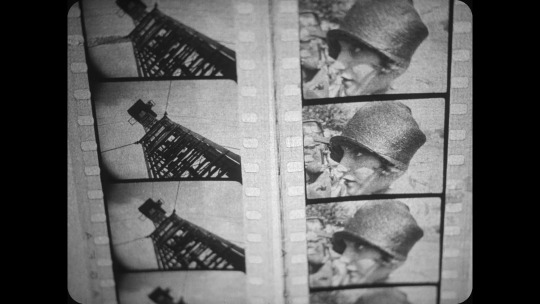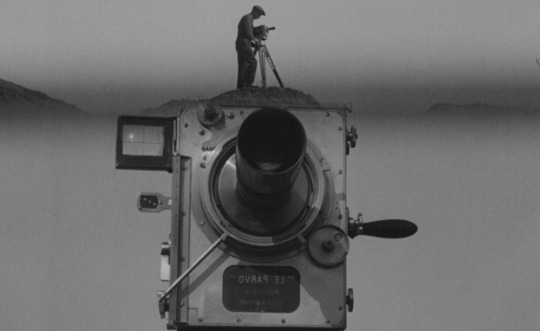#cinema verité
Text
These 23 seconds of local news from central Italy have literally become my favorite movie therefore I gave it English captions so that it could be shared with the rest of the world
#cinema verité#italy#i took some liberties with the translation because the original speech was rambling a bit and i wasn’t sure about rendering it in english#without making overlong captions#the last phrase is also a bit creative because it’s obviously cut off in the original audio but. it was too funny to pass on#sometimes you find yourself in situations.
12K notes
·
View notes
Text
A arte da montaxe soviética
youtube
Houbo épocas e lugares que foron o caldo de cultivo ideal para as persoas que quixeron coller o cinematógrafo e explotar as súas posibilidades até os seus límites, innovando, no proceso, a técnica e a narrativa cinematográfica para aportar ao que hoxe coñecemos como cinema. Os anos vinte do século pasado foron anos de vangarda e experimentación en todo o mundo, como xa temos mencionado nesta mesma bitácora, en todas as artes e no cinema en particular; mais se viaxamos até a Unión Soviética naquel tempo en particular, atopamos unha pequena revolución cinematográfica dentro da grande revolución social, política e económica que cambiou a face do mundo para sempre.
Para resumir de maneira sinxela, atopamos un territorio que vén de sufrir un tremendo cambio a todos os niveis. É un pobo na busca da súa propia expresión artística, como tamén o foi no seu momento a Alemaña de entreguerras -berce do expresionismo alemán- e de diferenciar as súas películas do melodrama burgués que poboaba as salas de cinema americanas. Por suposto, tamén había intencións propagandísticas -non llas negariamos tampouco ao western norteamericano dos tempos da Segunda Guerra Mundial, non si?- e didácticas; estamos a falar dunha poboación cunha alta taxa de analfabetismo, que arrastraba dende a época dos tsares, no que o cinema podía converterse na mellor maneira de trasladar as ideas revolucionarias á xente. Como o foi, no seu momento, a escultura policromada das catedrais góticas.

A URSS disponse, polo tanto, a nacionalizar a industria cinematográfica e a crear todo tipo de institucións e organismos para erguer a súa produción, como o caso de Mosfilm (os estudios de cinema de Moscova) e mais o Instituto Pansoviético de Cinematografía, nada menos que a primeira escola de cinema da historia. Había arelas de experimentar, de estudar e de reinventar. Era o momento e o lugar axeitado para que o cinema despegase nas mans de figuras como as que imos tratar a continuación.
O grande paso adiante da cinematografía soviética foi, sen dúbida, o desenvolvemento e a expansión dos límites da montaxe audiovisual; até o momento, cineastas como D. W. Griffith levaran a linguaxe cinematográfica até novos territorios, con innovacións respecto ao cinema primitivo como as que supuxo a escala de planos -o uso de planos detalle, primeiros planos ou planos xerais-, a dirección, a duración e o ritmo dos mesmos, a estrutura das secuencias... dende o cinema soviético aínda levaron un paso adiante, comprendendo que o espectador era capaz de asimilar usos da montaxe máis complexa, e facendo que a montaxe en si mesma aportara novos significados á narrativa. De aquí ven o efecto Kuleshov, por exemplo; do análise, estudo e experimentación das posibilidades da montaxe dende un punto de vista intelectual.

Sergei M. Eisenstein naceu en 1898 en Riga, Letonia, daquela parte do Imperio Ruso. Bolxevique convencido, foi o máximo representante -polo menos o máis coñecido- desta etapa de vangarda na montaxe cinematográfica. O seu cinema era o cinema-puño, que procuraba unha reacción no espectador a través do que el denominaba montaxes de atraccións, técnicas de diversa natureza que, por primeira vez, daban importancia á sucesión dos planos como un fin en si mesmo, como a unión de ideas para ter como resultado novos conceptos, non só como un mero medio de enlazar escenas. Non imos explicar a fondo as técnicas da montaxe de atraccións -el mesmo escribiu máis dun libro que o aborda en profundidade- porque nos levaría todo o artigo e ficaríamos curtos, mais é importante saber que o cinema-puño trataba que a audiencia se sentise motivada ou impresionada grazas ás asociacións de imaxes que estaba a contemplar. Comparar, por exemplo, ao pobo ruso sometido á represión dos tsares coas imaxes dun matadoiro de gando, tiña que facer ferver o sangue a quen o ollase e suscitar a empatía cara as vítimas do poder.
As principais películas de Eisenstein son afíns á causa soviética, tendo sempre á clase proletaria -á masa social- como protagonista, destacando pola súa sona O acoirazado Potemkin (Броненосец Потёмкин, 1925), e a súa coñecida escena da escada de Odessa, imitada unha e outra vez ao longo da historia do cinema. Mais tamén se podería destacar nesta etapa Октябрь (Outubro, 1927) ou Старое и ново (O vello e o novo, 1929), nas que a montaxe de atraccións chega ao seu auxe. O cinema de Eisenstein é, sen dúbida, o cinema máis puramente revolucionario.

Mentres que Eisenstein e outros cineastas soviéticos -dos que xa falaremos chegado o momento- se adicaban á ficción, houbo varias persoas que creron no xénero documental como forma máis pura do cinema. Antes de meternos nos movementos e nos manifestos, imos falar dunha cineasta quizabes menos coñecida mais -como xa veremos a continuación- tamén podemos atribuírlle un dos fitos da historia do cinema.
Esfir Shub nace en Surazh, Rusia, en 1894. Traballou no estudio Goskino editando filmes estranxeiros, o que a fixo desenvolver un método de montaxe propio que foi influencia para xente como Eisenstein ou Vertov. A Schub debémoslle a creación de todo un xénero cinematográfico como é o documental de arquivo ou found footage -metraxe atopado-, os filmes que se constrúen a través da montaxe de metraxe recopilado dende diversas fontes documentais, polo tanto “prestado” desas fontes e non filmado de novo -non se debe confundir co recurso de ficción que consiste en “falsificar” o achado dunha metraxe como dispositivo narrativo que introduce o relato-.

No documental Падение династии Романовых (A caída da dinastía Romanov, 1927) albíscase a vontade de deixar ao metraxe falar por si só, no canto de sometelo a cortes rápidos e analíticos como nos traballos de Vertov, e esta quizabes é a diferencia principal entre estas dúas figuras centrais no desenvolvemento do formato documental. A clave do novo xénero do documental de arquivo é a resignificación do metraxe a través da montaxe, é dicir, o afastarse da intención orixinal co que foron captadas as imaxes para achegar novas interpretacións a través da súa unión con outras ideas visuais. Por poñer un exemplo -presente no vídeo introdutorio- mesturar os filmes domésticos da familia do tsar nos que os nobres rematan axados de bailar e festexar coas imaxes da clase proletaria a suar para sacar adiante o seu traballo e con iso sobrevivir, é unha maneira de manifestar a existencia da loita de clase e da lexitimidade, polo tanto, da revolución.
Mencionamos brevemente a Dziga Vertov, nado en 1896 como David Abelevich Kaufman na Polonia tamén pertencente ao Imperio Ruso naquel entón. O espírito de Vertov era verdadeiramente vangardista, e xunto ao colectivo do que tamén formaban parte o seu irmán Mikhail Kaufman e mais a súa muller Elisaveta Svilova creou en 1922 un manifesto, o “Nós”, no que reivindicaba o desenvolvemento do cinema-ollo ou Kino-oki -sóavos de algo?- como unha maneira de filmar a verdade sen intervención nin artificio. Tempo antes, traballara para o Kino-Nedelya, o noticiario audiovisual soviético, onde coñeceu a Svilova. Posteriormente crearían o noticiario Kino-Pravda, que se pode traducir como cinema-verdade e que tiña como obxectivo o de captar a realidade tal e como era, coa maior obxectividade posible, para o que utilizaban técnicas como a cámara oculta. Esta corrente foi a base sobre a que os cineastas franceses corenta anos máis tarde crearon o cinéma-vérité, sobre o que xa haberá ocasión de falar, mais que se trata dun dos movementos cinematográficos de documental máis importantes da historia.

Segundo a filosofía do Kino-oki, Unicamente se permitía a intervención na montaxe, cuxa excelencia tamén marcou a obra de Vertov en filmes marabillosos como Человек с киноаппаратом (O home da cámara, 1929). No que, por certo, aparecen en pantalla tamén, ademais de Esfir Shub e mais o irmán de Vertov, Kaufman -é o home da cámara, precisamente-, a nosa seguinte cineasta: Elisaveta Svilova.
Non se pode entender a influencia de Vertov sen coñecer a Svilova, a pioneira da montaxe e, precisamente, a montadora do documental Человек с киноаппаратом. É seu o mérito do ritmo frenético do filme e a agudeza á hora de enfrontar ideas a través das súas imaxes. Tamén a achega de recursos como a dobre exposición. Svilova, Kaufman e Vertov querían anunciar, co seu manifesto e o seu traballo materializado en filmes como O home da cámara, a morte do cinema tal e como se coñecía, o cinema como síntese das artes literarias e teatrais, en favor dun cinema novo que, por suposto, tiña que ter a montaxe -a característica diferenciadora do arte cinematográfico- como base fundamental.

Svilova fixo carreira tamén fóra do colectivo. Ademais de participar en noticiarios durante a Segunda Guerra Mundial, da que foi unha de tantos cronistas, é súa a filmación da liberación do campo de concentración de Auschwitz por parte do Exército Vermello, e tamén documentou os xuízos de Nuremberg.
Todo o xenio experimental da cinematografía soviética dos anos vinte perdeu alento coa chegada do movemento do realismo socialista, promovido polas mesmas institucións que no seu momento impulsaran as carreiras destes cineastas. Porén, fica para a posteridade que o cinema que coñecemos non sería o mesmo sen a aportación destas mulleres e homes que tiveron a oportunidade de crear e desenvolver a súa propia revolución cinematográfica.
Até o vindeiro episodio!
#soviet filmmakers#elisaveta svilova#dziga vertov#esfir shub#serguei m. eisenstein#eisenstein#soviet era#kino-pravda#battleship potemkin#kino-oki#cinema verité
3 notes
·
View notes
Text
⠀⠀⠀⠀⠀ ⠀⠀ ⠀ 𝒷𝒾𝑜𝓈 ❀ ̭͡ ✧ ✧

⠀⠀⠀⠀⠀⠀ ⠀ ❛ ⟡ ˖͢ exclusive.mp3 ◌ ⃘۪֗.✦✧
⠀ 私たちの千の冬 , Nuestras ⭐️ Primaveras
ׁ εεε ଓ 。. ✿❀ ྀི Poet’s Lake 🪷 * 𓈒
⠀ ⠀ ε ❤︎ з ⠀ ᭄ ˖ ॱ Heart-Shaped Kisses 👩🏻❤️💋👩🏼
▒ ❀ ̭͡⠀ Cinema Verité, (1981) 人月
⠀ ⠀ 💧 𖣁 ूूूੂ ❀ #⃝ 19͟8͟9 ❜
⠀ ⠀ ○ *️⃣ ♥︎ OH , DARLING ! ᧔◍᧓ ˖ ݁ ıl

#bios#⭒⠀ •̩̩͙*˚⁺‧͙⠀ ✩⠀ •̩̩͙*˚⁺‧͙⠀ ⭒#arrancarmelos#messy simbols#short bios#long bios#aesthetic bios#messy bios#random symbols#random bios#random locs#cute bios#symbols bios#taylor swift bios
3K notes
·
View notes
Text






▒ ❀ ̭͡⠀ Cinema 👖 Verité, (1981) 人月



#( ⑩ ) — 𝑠𝑖𝑐𝐡𝑖𝐦𝑖#yunjin mb#lesserafim yunjin moodboard#le sserafim yunjin moodboard#yunjin lesserafim#yunjin le sserafim#lesserafim yunjin#le sserafim yunjin#yunjin aesthetic#yunjin moodboard#yunjin#weirdcore#weird#weird moodboard#random#random moodboard#kpop moodboard#kpop locs#moodboard#aesthetic#aesthetic symbols#kpop aesthetic#kpop layouts#aesthetic kpop#cool moodboard#y2k moodboard#y2k aesthetic#dark moodboard#dark#aesthetic kpop moodboard
82 notes
·
View notes
Text
▒ ❀ ̭͡⠀ Cinema Verité, (1981)




私たちの千の冬 , Nuestras ⭐️Primaveras



⠀. ○ 🌳♥︎ OH , DARLING ! ᧔◍᧓ ˖ ݁ ıl
#kpop layouts#messy layouts#random layouts#kpop moodboard#moodboard#pink layouts#aesthetic layouts#bg layouts#bg messy layouts#bts moodboard#bts layouts#bts theme#bts packs#☆ 🕷️ 𖦹 f4irytki#𝖼𝗅𝗂𝖼𝗄ᵎᵎ © ☆ f4irytki#ᵎᵎ © f4irytki#jungkook layouts#jungkook moodboard#jungkook packs#jeon jungkook moodboard#divider by v6que#divider by plutism#green moodboard#bg moodboard#bg packs#bangtan moodboard#bangtan layouts#jk layouts#jk moodboard#jk packs
60 notes
·
View notes
Text



⠀ ▒ ❀ ̭͡⠀ ⠀⠀ Cinema ͏ ͏ ͏ ͏ ͏ ͏ ͏ Verité, ͏ ͏ ͏ ͏ ͏ ͏ (1981) ⠀⠀人月




#🌬️ུ᳝᳜᳝ࣺ͒ ✦ 🍈 ✧ 🤲🏻 ⠀🌫️ ✦#solo una chica tonta más bajo el sol ❤︎ como una propaganda de bronceador.#⠀⠀ ⠀⠀ ⠀⠀ ⠀⠀ ⠀⠀ ⠀⠀ ⠀⠀ ⠀⠀ ⠀⠀ ⠀⠀ ⠀⠀ ⠀⠀ ⠀⠀ ⠀⠀ ⠀⠀ ⠀⠀ ⠀⠀ ⠀⠀ ⠀⠀ ⠀⠀ ⠀⠀ ⠀⠀ ⠀⠀ ⠀⠀ ⠀⠀ ⠀⠀ ⠀⠀ ⠀⠀ ⠀⠀ ⠀⠀ ⠀⠀ ⠀⠀ ⠀⠀ ⠀⠀ ⠀⠀ ⠀#chowon#moodboard#mb#clean moodboard#soft moodboard#ichillin#ichillin moodboard#ichillin chowon#vintage moodboard#aesthetic moodboard#indie moodboard#kpop moodboard#coquette moodboard#gg moodboard#kpop gg#chowon moodboard#beige moodboard#white moodboard#archive moodboard
92 notes
·
View notes
Text

25 notes
·
View notes
Text
me trying not to explode with a rant about dogme 95 and cinema verité and the thick of it and multi-camera set-ups whenever someone calls succession an ugly show

#that being said season 1 is cinematically indefensible they hadn't figured out what they were doing#yet!!!! then season 2 is perfect. they peaked#text#succession
21 notes
·
View notes
Text
the drowned post filter is not enough i need to create an short art film in the style of cinema verité in which the post begins to glitch and dissolve, serving as a commentary on the divide between the digital and the real
#(this is not about any post in particular this is just a baseline mood)#this is however specifically about Liminals by Jeremy Shaw which I saw in 2019 after thinking i bombed a board exam
8 notes
·
View notes
Text
Recentish adventures in gay vampire movies:
THE VAMPIRE NEXT DOOR (2024): More properly a bisexual vampire movie (eventually, if you're patient), this is a dumb low-budget comedy about a 20-something dweeb, Cameron (Alex Matthews), who's persuaded to act as chauffeur/getaway driver for his hot new next-door neighbor Victoria (Jessica Ferguson) while she does some vampire murders around town. Meanwhile, Cameron is secretly in love with his hot blond bestie Diane (Bella Chadwick), for whom hot himbo Martin (Andrew Larkin) wants Cameron to do the Cyrano de Bergerac thing. An underwhelming throwback to the dopey (PG-rated) teen sex comedies of the '80s (with ONCE BITTEN an obvious comparison), the movie spends so much energy on the romcom stuff that it takes forever for the vampire stuff to come into focus, and, as in many bad '80s comedies, an awful lot of the plot hinges on Cameron being an "innocent" Peeping Tom. Sort of amiable despite having no real redeeming virtues, but it's weighed down by Alex Matthews, whose character is unsympathetic and whose head-lolling performance suggests that he's recently been hit with a tranquilizer dart.
BIT (2020): MEAN GIRLS meets THE LOST BOYS, featuring a teenage trans girl from Oregon, Laurel (Nicole Maines), who comes to L.A. to spend the summer with her brother (James Paxton) and falls in with a clique of gay vampire girls led by the sardonic Duke (Diana Hopper). Funny and stylish, it suffers from trying to cram at least five hours' worth of plot into 90-ish minutes of screen time. Many of the component pieces are interesting and fun, but as a whole, the movie feels jumbled and unresolved: Various subplots and secondary characters go nowhere; the other vampires (Zolee Griggs, Char Diaz, and Friday Chamberlain) get hardly any character development — Griggs' character Izzy is there mostly as Laurel's love interest, and Diaz and Chamberlain barely have any lines; and Laurel remains curiously underdeveloped, reducing her to a fairly generic teen movie protagonist. Maines is an appealing screen presence, but she can't compete with Diana Hopper, whose commandingly bitchy performance as Duke is the centerpiece of the movie. There's a lot to like about BIT, but it might have worked better as a TV series, giving the characters and story more room to breathe.
THERESA & ALLISON (2019): Extremely low-budget cinema verité horror comedy-drama about gay college girl Theresa (Arielle Hope), transformed into a vampire after a disastrous one-night stand, as she struggles to navigate her new vampiric existence while nursing a crush on a somewhat older vampire, Allison (Sarah Schoofs) — who is totally, definitely (not) broken up with her obnoxious boyfriend Tony (Charles D. Lincoln, who also wrote the script), who now won't leave Theresa alone. The production values are modest and the acting is uneven, but this is a much more cohesive movie than the other two, with far and away the most intelligent script and many inventive ideas (like the fact that New York City has social services for vampires, although like most urban social services, they're underfunded and totally inadequate). Its biggest strength is the way the story builds its vampire-related elements around familiar real-world gay girl travails, which is sometimes very funny as well as horrifying. The caveat is that this is still definitely a horror movie, and goes some quite dark places (requiring CWs for suicide and sexual violence, beyond the usual for vampire stories), with an ambiguous but rather harrowing ending.
#movies#hateration holleration#the vampire next door#bit movie#theresa & allison#sean king#alex matthews#jessica ferguson#bella chadwick#andrew larkin#nicole maines#james paxton#diana hopper#zolee griggs#char diaz#friday chamberlain#arielle hope#sarah schoofs#charles d lincoln#wlw
5 notes
·
View notes
Note
I'm not saying she went to the wedding at all. She wasn't sighted there. I'm just hypothesizing that might have been a time she could have turned up in MA because he was at home at that time for a more extended period during Ghosted filming.//
If the video was done in April, I would have liked to have heard that conversation.
Chris: Hay BABY 🤮I'm going to be home in April for my sisters wedding in April. Do you want to come and do some scare videos
AB: I’d love to, BABY 🤮 what color dresses should I wear?
Chris: What? No. You can come do scare videos but you're not coming to my sisters wedding
AB: But it would sell the narrative your family loves me.
Chris: Scare videos only.
AB: Fine.
This is so believable it's almost cinema verité, lol.
25 notes
·
View notes
Text
Ok, nobody is happier than me to see people rediscovering classic cinema, but I feel like so many posts are just ignoring or handwaving how problematic Goncharov is. Like, I get it! It's got all the elements of Scorsese in his prime, but just a little bit rougher around the edges. It's got this not-quite cinema verité quality. It's got Pacino looking like that and Cybill Shepherd looking like oh my god, and you don't want to see its flaws. I don't want to see its flaws. But we need to talk about things honestly, and I don't want young people watching it uncritically. That's just irresponsible.
11 notes
·
View notes
Text
Definitions Don't Vary
Hi Skippy & Friends-Pilgrim here confirming real meanings starting with the definition for "documentary film."
NON-FICTIONAL MOTION-PICTURE=Documentary film. (Whoops!)
Wikipedia says: A documentary film or documentary is a non-fictional motion-picture intended to "document reality, primarily for the purposes of instruction, education or maintaining a historical record ".
Webster says: “a movie or television program that tells the facts about actual people and events.” The conventional thinking about documentaries is that they document reality. Also, conventional thinking suggests they represent the objective truth and do not include fictional elements.
There are 6 primary types of documentaries according to Peter Biesterfeld-a seasoned script-to-screen writer and producer/trainer.
1. The Expository Mode-heavily researched essay films that air to educate and explain events, issues, ways of life and things we know little about.
2. The Observational Mode-called cinema verité, for fly-on-the-wall documentary; gritty realism produced in the 1960-70's using new, faster, lighter filming equipment.
3. The Participatory Mode-involves the meeting between filmmaker and subject recorded with the filmmaker engaging in the situation they are documenting. It presents the filmmaker's point of view.
4. The Reflexive Mode-These try to provoke audiences to question what is being presented! Reflexive documentaries challenge assumptions/expectations about the form itself.
5. The Poetic Mode-the definition of poetry in applied, creating an impression or a mood rather than show a point. It is an abstract or avant-garde production, emphasizing cinematic value over content to create visual poetry using shot design, composition and rhythm.
6. The Performative Mode-this is the opposite of the observational mode where the story is told in an unobtrusive way following the subject's narrative. Performative docs emphasize the filmmaker's own involvement with the subject, becoming the film's personal guide filled with raw emotion and what it is like being there-perhaps a culture of event in history. They may include found footage telling the tragic story of the subject matter.
Conclusion: the Archewell effort for producing a documentary has actually created a new catagory called REVERSING TRUTH MODE. By using all of the above techniques, the intention is to create such a mix up of information it becomes worthless visual pollution, causing severe raw reactions. Caution is advised with this form of documentary with its overly dramatic, scary music used to accentuate the non-existent danger while triggering stress!
Back to reality...I want to know, when do the movie regulators start to question this fake documentary legally? Netflix should be fined along with any other group that participated in this creation of FICTION. Advertising it as a documentary, defined by traditional dictionaries used worldwide, they have perpetuated FRAUD to an unsuspecting public.
"Big mistake! Big! Huge!" said the character from the scene in the movie Pretty Woman. Over and out for now.
Excellent post! Thank you Pilgrim!❤️
11 notes
·
View notes
Text
Intro to Film Studies, Ch. 9: Documentaries
1. How do we recognize and define documentary as a distinct form?
2. What types of documentary are there, and how do they overlap and interact with each other?
3. What relationship does documentary have with fiction, drama and reconstruction?
4. In what ways does the notion of performance problematize documentary as a form?
What is a documentary?
subgenre of non-fiction
makes observations about the real historical world, rather than fabricated fictional worlds
yet these boundaries are fluid. As we will see, several documentaries have re-enactments or even fictional narratives.
One of the earliest and most famous definitions is by John Grierson “a creative treatment of actuality.”
If we recall, ‘actuality’ was the term we used in relation to the early films like Lumiere’s Workers Leaving the Factory.
Actuality: derived from the French term actualite given to the short non-fictional films made in the early period (1895-1906 or so). These films often consisted simply of people going about their everyday business, or of particular events (sporting contests, visiting dignitaries).
associated with novelty, cinema of attractions
can be considered proto-documentaries
the technology was the star
accompanied by music, introductions, voiceovers, etc.
Educational/Informative
- not just “capturing truth,” but a filmmaker’s shaping of “reality” of that subject material
- Grierson states that the difference between recorded material and what we might call a documentary is “a method which describes only the surface values of a subject, vs. a method which more explosively reveals the reality of it.”
Bill Nichols’ six modes of documentary:
1. Poetic (mood or tone of a subject)
Ex. Berlin: Symphony of a Great City (1927), Koyaanisqatsi (1982)
2. Expository (designed to persuade)
Ex. An Inconvenient Truth (2006)
3. Participatory (filmmaker actively engages with the subject)
Ex. Michael Moore’s documentaries
4. Observational (appearance of neutrality/detachment)
- shows a desire to preserve some way of life
- Flaherty did fabricate events; questions of ethics are very important.
Ex. Nanook of the North (1922)
5. Reflexive (commenting on the documentary itself)
- encourages the viewer to think about the representation
- Ex. The Thin Blue Line (1988)
6. Performative (filmmaker & subject are actively performing and co-creating the documentary)
- Ex. Grey Gardens (1975)
* These categories are flexible and may blend into each other. Different modes can be dominant in different scenes.
Post-war developments in documentary film
less confrontational, more observational
longer shots, lighter handheld cameras
development of Direct Cinema
French filmmakers moved in the opposite direction, towards cinema verité, in which the filmmaker has interacts with the subjects openly and doesn’t try to hide their involvement.
Direct cinema: A type of documentary filmmaking that emerged in the US in the 1950s, associated with Robert Drew, Richard Leacock, Don Pennebaker, Frederick Wiseman, and the Maysles Brothers. Direct Cinema films often have a ‘fly on the wall’ aesthetic, linked to the strong belief that the filmmakers were mere observers of the reality they were filming. This apparent detachment and neutrality has been as controversial as it is influential.
Cinema verité: The French term (literally meaning ‘cinema truth’) is sometimes confused with a US kind of filmmaking which is actually closer to direct cinema. The confusion stems from the common ‘immediacy’ that the films have – filming people with handheld cameras and portable sound recording equipment – but cinema verité properly has a foundation of interaction between filmmaker and filmed, rather than the detachment seen in direct cinema films.
Reality TV: a relatively recent development in television, a form of highly structured program using observational material of ordinary people. The programs have a ‘documentary’ basis in the sense that they use actuality footage, but they are often shaped to fit specific formats (game shows, dating shows, before/after, etc.). In this respect, reality TV is a good example of how documentary can be taken and recontextualized by contemporary television to suit its schedules.
Rhetorical: Designed to persuade. Rhetorical strategies in documentary are those that relate to the film’s or program’s argument. This may be explicit (e.g. a voiceover or presenter actually stating what the argued points are), or it may be less immediately obvious (e.g. a filmmaker might cut from an image of a political leader to a shot of a firing squad; this could be seen as an argument against the politician).
Topicals: The name given to nonfictional ‘news’ items in the early period. A royal visit, the opening of a factory, a sports event – anything that could be of interest to a local audience – could be labelled ‘a topical’. As documentary developed as a form, topicals were subsumed into newsreels and other forms of film reporting.
Participant observation: A social science methodology where researchers immerse themselves in the social context/group they are studying, often for years at a time. In documentary terms, such an approach arguably leads to more ‘natural’ responses, as the subjects have become used to the filmmakers and cameras.
Ethics: concerning morality, or codes of conduct. There is a strong ethical discourse running through the history of documentary, and debates to be had about the ethical dimension of things like reconstruction, filming people without their consent, informing the viewer of the extent of filmmaker intervention, and so on.
4 notes
·
View notes
Text

"Muere, Hart"
Kevin Hart está harto de ser encasillado como actor de comedia, y de que le pidan acudir a shows en directo para hacerse el graciosete y ponerse a bailar. A él lo que le gustaría es tener un papel serio en una película de acción. Tendrá la suerte de que le escuche el prestigioso director de género Claude Van de Velde, que le ofrece un papel, pero antes le exige que acuda a la Escuela de Actores de Acción, donde se han formado estrellas como Tom Cruise y Matt Damon.

Cine dentro del cine paródico, cuyo título original, “Die, Hart”, alude a “Die Hard”, el título original de "Jungla de cristal". Con una trama bastante elemental que juega al despiste de si están haciendo una película con Kevin Hart con cámaras ocultas, el nuevo “cinema verité”, vemos al protagonista interactuar con el algo alocado director de la escuela, interpretado por John Travolta, y con otra aspirante a actriz de acción, que debe prepararse para la nueva película de Kathryn Bigelow, y que interpreta Nathalie Emmanuel.

En fin, lo que le pides a un film de estas características es poder reírte a gusto, y la verdad es que ni estando a favor aflora la sonrisa con facilidad, quizá ocurre cuando aparece Jean Reno interpretando al director. Se trata de un “quiero y no puedo” que en algunos tramos puede resultar algo repetitiva.

Para los que tienen un sentido del humor fácil es una buena propuesta .. John Travolta impecable como siempre.
youtube
2 notes
·
View notes
Text
The opening of director Vincent Grashaw and writer Robert Alan Dilts’s What Josiah Saw (2021) reminded me of The Texas Chainsaw Massacre (1974). Momentarily beautiful and serene in a way but you know deep down something is about to be wrong. By minute three, I thought I was settling in for a movie about the origin of a very specific type of male evil that is pervasive in American society. What breeds it? Well, poverty for one thing. Alcohol and drug addiction don’t help. Total lack of healthcare and rural infrastructure collapse certainly exacerbate it. But who do these men blame? Women. Politics. Cabals of <insert non-white race here> that sex traffic children in basements of pizza parlors. Basically, anyone who isn’t them or the actual people/corporations responsible for decimating their community. Namely, the oil company that shows up by minute ten and wants all the land. There’s just one problem. One of the properties they have their eye on, local legend has it, is haunted. But the setup is a rope-a-dope. The film ultimately turns in something truly surprising about the secrets we keep and the lies we tell ourselves in order to keep them.
I was sold on reviewing this film by the trailer. When I saw Nick Stahl’s name, I literally squee-d. Nick Stahl is one of those actors I’ve always rooted for. I loved him in Carnivale (HBO) and Sin City (2005), just to name a couple, and years back when he was in the news struggling with serious drug addiction, I was honestly worried we would lose him. But here he is as Eli Graham and I hope to everything it means he is happy, healthy, and back to working consistently—and not so much that the character he plays, a wanton, lost, drug addict was an easy role to take. Stahl’s talent has always shined bright and it is on full display in this performance. Not to be outdone, even Robert Patrick’s hair is drunk during his performance as the perpetually inebriated, broken, titular Josiah Graham. Sure, he chews a little scenery, but goddammit, that’s why I love Robert Patrick. Stahl’s competition goes even deeper than that. The supporting cast is so good, it almost seems like it doesn’t belong. Standouts include Tony Hale (Arrested Development) as Ross Milner, Kelli Garner (Godzilla: King of the Monsters) as Mary Milner, and Jake Weber (Dawn of the Dead) as Boone. One I’ll definitely keep my eye on is Ronnie Gene Blevins who is quietly hilarious as Billy.
The film unfolds across three interconnected chapters. It moves and speaks like a well-written novel with the horror elements peppered in—as if Jim Thompson and Daniel Woodrell baked a cake in Stephen King’s oven—the same one that baked Dolores Claiborne (1995). What, to me, were a few cliché compositions and shots were more than made up for in some really unique and creative sequences. A fight scene in Chapter 2 is a personal favorite. Overall, Chapter 3: Mary May I is probably my favorite. It looks, sounds, and feels like a beautiful homage to The Shining (1980) but, like, if Wendy never took anyone’s shit.
Neo-noir is getting to be more and more difficult of a label for me to use. Given the state of the world, the darker, more hopeless and cynical aspects of noir as a genre in film simply feel at this point like Cinema Verité. So, with this film, dare I coin a new film movement, Cinema Amerité: the American answer to the original French movement which is basically filming horror/noir as if it’s documentary because that’s how hollowed out our daily lives have become. All of us pretending we’re not collectively experiencing various levels of PTSD in a seemingly endless cycle of shock, horror, and despair with no room for healing in a barely wage-livable forty plus-hour work week. Smile at dinner parties. Put up a Live, Laugh, Love sign in the living room. Suffer quietly. But what I always hold on to, and I think the film does to, despite its twist and very bleak conclusion, is remembering the connections we have to each other. Family, friends—even if those connections are strained, or broken, you always have the chance to go home—fix them, maybe. Or, at the very least remind yourself why you’re a fighter still fighting and a survivor still surviving. Stick around for the song running under the credits, “Dynamite Mine” by Murder by Death. It’s great.
#love this review#what josiah saw#love his love for nick stahl because- same!!!!!!#and lol at 'even robert patrick's hair is drunk' 😄#great movie and well worth the praise
4 notes
·
View notes